Do you spend countless hours preparing for your sessions? Are you printing, copying, laminating, and cutting more often than you would like? Is your “to-do” list growing by the hour? Would more time improve your sanity? If you answered, “yes” to any of these questions then it is time to claim your life back.
Spend more time enjoying what you love and less time prepping! You could be saving a substantial amount of time and money by incorporating digital resources into your daily routine. No more standing in line at the copier, just project onto your Smartboards or grab your devices and GO!
Digital resources are not only great on your wallet (no expensive ink, paper, or laminating sheets to buy) but students are VERY motivated by the technology. They truly get excited whenever you pull out the iPad, tablet, or use the Smartboard in your lessons. For me personally, I work as a teletherapist, so technology is the foundation of every session. What I have learned is that students love technology and I get more trials because I spend less time on external reward systems. The digital materials act as both a learning tool and reinforcement. This is an awesome win-win scenario. I have witnessed better outcomes because my students are eager to participate and are having FUN WHILE LEARNING!
If you are new to using digital resources with your students, or are reluctant to try them, I would like to provide you with a number of options. This will guide you through to make you feel more comfortable. I have received so many emails over the past few years and a common question I get is, can I use BVG SLP digital resources in face to face therapy? The answer is, ABSOLUTELY! People also want to know exactly HOW to use them on various teletherapy platforms.
For those of you who have been using digital resources for a while and who are my regular customers, the feedback is greatly appreciated. A lot of comments speak to how easy my resources are to use, how thorough/comprehensive they are, and how much your students love the technology. I really LOVE hearing from you so please keep your questions and comments coming.
I would like to give you an overview of each of the digital formats that are available. I have also included a few videos to provide you with an example of exactly how to make the most of the resource for both your teletherapy platform or your face to face therapy needs. Please be sure to read all the way to the end to get a free digital resource to trial out with your students.
Boom Cards
Boom Cards are quickly becoming my MOST popular and best-selling digital format. If you haven’t heard about Boom Cards yet, you are definitely in for a treat. I have a couple of blog posts that go into detail about exactly what they are and how to use them. For the purpose of this article, I want to give you a brief overview of the amazing things Boom Cards have to offer. So what are they? They are digital interactive task cards, basically flash cards with a digital twist.
They are interactive and allow students to point and click on buttons, drag and drop items around on screen, and fill-in the blanks. These cards are so awesome because students receive immediate feedback to indicate if they are correct or incorrect, PLUS the cards are self-grading to save you time on data collection.
I have over 70 Boom Card decks available that address a wide range of concepts in a fun, engaging, and interactive way. To really understand exactly how you can use them with your students, it is best to try them out for yourself. There are several free ones in my store to give you a feel for them, please download and let me know your thoughts.
Seeing them in action is a great way to get a better idea of how they could work for you. The video above is a sample of one of my decks, there are many more to choose from that address a wide range of targets. Keep in mind all my Boom Card decks can be used for your whole group, small group, or teletherapy sessions.
They are compatible with Smartboards, tablets, iPads, and teletherapy platforms. When using in whole group, encourage students to approach the board and click on the correct answers. In small group, facilitate the session by using a tablet or iPad and have students take turns answering the questions or manipulating the items on screen.
For teletherapy platforms, they work best when using a Google Chrome browser and sharing your screen with your students. Follow these steps to share your Boom Card decks in session:
- Open your Chrome browser and go to the Boom Learning website.
- If you have already downloaded a few decks, log into your account and click on the “Library” tab to access your decks. If you have not downloaded any decks, no worries, there are a wealth of resources to choose from. You can shop directly on the Boom Learning website for the target goal you’re working on or you can visit the Teachers Pay Teachers website to shop for “Boom Cards” (narrow your search by adding a key word after Boom Cards, i.e. articulation, speech, comprehension, sequencing, etc.).
- When you have decided which deck to use with your student(s), click on the deck to open it. It is a good idea to familiarize yourself with the deck before working with you student so that you are comfortable navigating around the resource.
- With the Boom Card deck opened in Google Chrome and ready to play, you will now want to click over to your teletherapy platform. Every platform is different but the goal is to share your screen with your students so that they can see the Boom Cards. In Adobe Connect, click on “Share Screen” (this may be slightly different depending on the platform that you are using). Select the window that has your Boom Card deck loaded to share with your student.
- Once your student can see the Boom Card deck that is being shared, you may want to adjust the size of the window so it fits nicely within the platform. This can be done by clicking and dragging from the corners or sides. This will make it possible to see both your Boom Card deck and also still see your student for easy viewing while going through the deck.
- At this point, allow your student to “Request Control” and select the correct answer choices.
- Finally, guide your student(s) through the deck by providing cueing as necessary. Ask them questions and encourage them to respond using complete grammatically correct sentences. Differentiate the deck to make it more or less challenging for your student depending upon their individual needs.
Click here to learn more about my Boom Cards.
Google Drive
Today’s classroom is being driven into a Google revolution. More and more schools are providing ChromeBooks to their students for 1:1 digital learning, which is awesome. It is not only equipping our students with the tools they need to be successful in the real world, but it is also motivating them by incorporating something that they have grown up with. Students are very comfortable and eager to utilize the technology.
Make the most of it by ensuring that the resources they use in the classroom can also be used for carryover activities and homework outside of the classroom. This is a great time to stay abreast of all the awesome things you can do with Google Drive resources. I personally LOVE Google Slides for incorporating Digital Interactive Notebooks into my sessions. I have a number of Digital Interactive Notebooks available and enjoy using them with my students to address their targets during our sessions. I can then assign the digital notebooks for continued practice at home.
The Digital Interactive Notebooks are such a great tool because they are customizable and you, along with your students, can personalize them to focus on their individual level. If a student needs additional practice, my interactive notebooks include template pages to add more opportunities for them to demonstrate mastery. These digital notebooks can then be assigned for nightly practice and can even serve as summer homework packets to ensure that students don’t regress over extended breaks.
Once these notebooks are completed they are a great way to share with parents and classroom teachers exactly what students are working on during speech and language sessions. When using during small group, if you have the privilege of a 1:1 classroom, assign each student their own notebook to customize with guidance and assistance as needed.
If you are using the digital interactive notebooks in your teletherapy sessions, open them in Google Chrome. Sharing your screen with your students works best. Again, allow them to “request control” and as you address their targets have them customize their notebooks by adding pictures, filling-in the blanks, and manipulating the content on screen. Once they have completed the notebooks, email them a copy or share through Google Drive. This works great for continued reinforcement at home. Click here to learn more about my lessons for Google Drive.
Interactive PowerPoint
Another great option is the use of an Interactive PowerPoint. I have a series of Interactive PowerPoint resources that address vocabulary in a fun, interactive way. My Hide and Reveal Series presents students with a picture covered by squares that they click to uncover the picture hiding underneath.

The goal is to guess the picture in as few clicks as possible by tapping into prior knowledge. This is a great tool for making inferences and students get very excited by this activity. It addresses so many targets using real images and expository text. Students are required to describe, use context clues to define unfamiliar terms, compare and contrast, and I ask them questions throughout to gauge understanding. Click here to learn more about my Interactive PowerPoint lessons.
Flat PDFs
All of my resources are designed with a teletherapy platform in mind and many of my earlier products were in the format of a flat PDF. What this means is the file is in essence a PowerPoint presentation that has been flattened to protect the clip art and to prevent editing of the content. All of my PDFs are full-color and intended for digital use on teletherapy platforms, tablets, iPads, computers, and Smartboards. My PDFs are presented in a very systematic way to teach very important language and literacy concepts. The PDFs are very comprehensive and provide for several opportunities for your students to practice and demonstrate mastery.
For therapist using teletherapy platforms, most have a digital whiteboard built-in. This functions in much the same way as a Smartboard but it’s online and housed within the platform itself. With this built-in whiteboard, students are able to interact with the content by using the whiteboard features to circle, fill-in the blanks, highlight, draw, etc. on the slides.

For example, many of my articulation PDFs have game boards, Four in a Row, Connect the Dots, and BINGO cards to keep students motivated while drilling artic targets. By uploading the PDF to the platform and opening with the “draw” function enabled, students can make circles of varying colors to use while playing Four in a Row or draw lines to Connect the Dots when playing this very popular game.
If you are not using a teletherapy platform, but would like to make the PDFs more interactive for your students, I would highly recommend using a free annotation app. What this does is gives you the functionality of a built-in whiteboard directly on your iPad, tablet, or computer. Students would then interact with the content in much the same way as if it were being displayed on an interactive whiteboard. A few free ones to consider are Diigo, A.nnotate, Xodo, Tiny PDF, Miro, and there are so many more. Do a quick search to find the best one to fit your personal preference. Click here to learn more about my PDFs.
These are just a few of the digital resources that I have available in my store. I specialize in saving fellow SLPs, teachers, educators, and parents time and money by allowing them to incorporate technology into their instruction. I have over 170 digital resources that address language, literacy, articulation, phonemic awareness, following directions, vocabulary, comprehension, comprehension strategies, sequencing, story retell, grammar, and so MUCH MORE!
If you have any questions or concerns, please comment below or email me directly at belinda@bvgslp.com. I’m happy to help and look forward to providing you with more time to focus on what matters the most and less on prepping, printing, copying, laminating, cutting, organizing, and storing. To trial out one of my digital Boom Card resources, be sure to subscribe to my newsletter to have it delivered directly to your inbox for FREE.








Leave a Reply
Your email is safe with us.